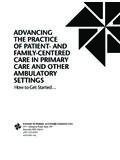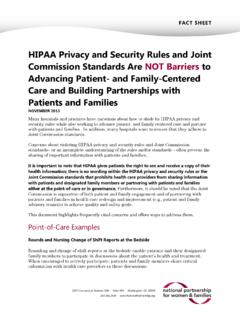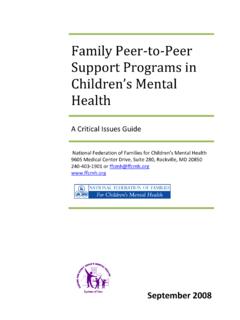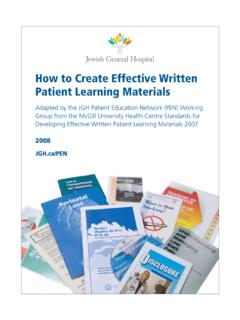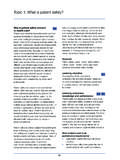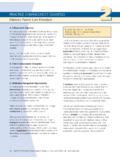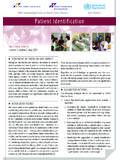Transcription of InstItute for atIent- and famIly-Centered Care
1 InstItute FOR PATIENT- AND family - centered care . 6917 Arlington Road, Suite 309 Bethesda, MD 20814 Phone: 301-652-0281 Fax: 301-652-0186 Partnering with patients and Families To Design a Patient- and family - centered Health care System A Roadmap for the Future A Work in Progress Jim Conway, Bev Johnson, Susan Edgman-Levitan, Juliette Schlucter, Dan Ford, Pat Sodomka, & Laurel Simmons With support from The Robert Wood Johnson Foundation June 2006. InstItute for family - centered care 7900 Wisconsin Avenue, Suite 405. Bethesda, MD 20815. In collaboration with InstItute for Healthcare Improvement 20 University Road, 7th Floor Cambridge, MA 02138. ! 2006. Permission is granted to duplicate material in this paper for educational purposes. Partnering with patients and Families To Design a Patient- and family - centered Health care System: A Roadmap for the Future 1 10/2010 InstItute for Patient- and family - centered care Table of Contents 3.
2 Patient- and family - centered care 4. Building Momentum for Patient- and family - centered care : Organizational Support .. 6. Building Momentum for Patient- and family - centered care : Social Forces for Change .. 11. Collaboration with patients and Families in Quality Improvement And Health care Redesign: What Does It Look Like? How Do We Know It Works?.. 13. Hospitals .. 13. Ambulatory Settings .. 18. Professional Education .. 21. Quality Improvement Organizations and Initiatives .. 22. Professional Associations and Disease-Specific Organizations .. 24. Patient Safety Organizations .. 25. Federal and State Agencies .. 27. Factors that Facilitate Collaboration .. 28. Barriers to 29. Moving Forward .. 31. 33. Partnering with patients and Families To Design a Patient- and family - centered Health care System: A Roadmap for the Future 2 3 10/2010 InstItute for Patient- and family - centered care Partnering with patients and Families to Design a Patient- and family - centered Health care Delivery System: A Roadmap for the Future Background Paper for June 2nd Meeting A Work in Progress Introduction Fixing the problems that plague health care in the United States, most experts now agree, demands system-wide solutions.
3 The health care system must be redesigned, and that enormous task must be undertaken collaboratively by all key stakeholders health care professionals, administrators, planners and policy makers, and payers, as well as by patients and their families. Such partnerships must begin with a shared understanding of the problems, and a shared commitment to work together to solve them. Only then can an action plan for redesigning the health care system be developed and implemented. This paper provides background information to facilitate the development of an action plan to ensure that sustained, meaningful partnerships with patients and families are in place in hospitals and health systems; in community clinics and other ambulatory settings; in schools educating the next generation of health care professionals; in national associations; in federal, state, and community agencies; in foundations and advocacy organizations; and among payers.
4 The paper was drafted at the request of the Robert Wood Johnson Foundation in preparation for a one-day invitational meeting convened by the InstItute for family - centered care (IFCC) and the InstItute for Healthcare Improvement (IHI) in Cambridge, Massachusetts on June 2, 2006. The meeting will bring approximately 25 patient and family advisors together with administrative and clinical leaders from hospitals and other health care organizations and leaders from foundations and the IHI. The goals for the meeting are: To advance the conversation to develop a shared vision and action plan for improving health care by advancing the practice of patient- and family - centered care and creating partnerships with patients and families in all health care settings and within the organizations and agencies having an impact on health care . To outline specific action steps and develop recommendations for: !
5 How to engage and support patients and families and health care professionals and administrative leaders in working together on quality improvement and the redesign of health care ;. 4. Partnering with patients and Families To Design a Patient- and family - centered Health care System: A Roadmap for the Future 3 10/2010 InstItute for Patient- and family - centered care ! How to overcome the barriers to creating and sustaining these partnerships; and ! How to build the evidence, resources, structures, processes, and community to support and sustain this work. To build commitment and synergy among participants and their organizations to advance patient- and family - centered care and to ensure that meaningful and sustained partnerships are an essential component of quality improvement and the redesign of health care in the future. The purpose of this paper is to give meeting participants a common ground and to facilitate discussions during the June 2nd meeting.
6 It begins by tracing the development of the term patient- and family - centered care . It then discusses the organizational and societal forces that have contributed to the current momentum for partnership building. The next section of the paper illustrates what patient- and family - centered care and partnerships look like in action; the examples are in some cases accompanied by evaluation and research findings that document the positive impact of patient- and family - centered change. The paper then lists a number of factors that experience and research have confirmed are essential to advancement of patient- and family - centered care ; this is followed by a discussion of common barriers to progress. The paper concludes with the outline of key components of a plan for moving toward developing an action plan for building and sustaining partnerships among patients , families, and professionals in health care to achieve the outcomes of quality care desired by all.
7 This section will serve as a basis for small-group discussions on June 2nd. Patient- and family - centered care Defined Efforts to enhance patient and family partnerships in health care redesign must be based on a shared understanding of key terms that often come up in the health care literature and in discussions of quality improvement. Of these terms, none may be as critical as patient- and family - centered care . A brief history of how this term developed and of the organizations and individuals that contributed to the definition is therefore a necessary foundation for informed, productive discussions of engaging patients and families in the redesign of health care . Balint and colleagues introduced the term patient- centered medicine in 1969. 1 The term patient- centered care was coined by the Picker Commonwealth Program for Patient- centered care , subsequently the Picker InstItute , in 1988.
8 At that time, this group began to do research aimed at documenting patients ' needs and preferences in order to understand the patient's definition of high quality care . The group also began to explore models of care that could better address those needs. This research began with qualitative research aimed at understanding how patients and their families defined the quality of care in hospitals and, ultimately, across the continuum of care . The Picker Commonwealth Program for Patient- centered care used findings from focus groups and interviews with patients and families to create survey instruments that measure the patient's experience of care . These surveys, conducted by the Picker InstItute for health 5. Partnering with patients and Families To Design a Patient- and family - centered Health care System: A Roadmap for the Future 4 10/2010 InstItute for Patient- and family - centered care care organizations in the United States, Canada, and Europe, measured patients '.
9 Experiences in eight dimensions of care : access; respect for patients ' values and preferences; coordination of care ; information, communication, and education; physical comfort (including help with activities of daily living); emotional support; involvement of friends and family ; and preparation for discharge and transitions in care . In addition to safe and technically excellent care , these dimensions are deemed to be the most critical aspects of the care experience by patients and their In the United States, childbearing women and families helped drive family - centered changes within maternity care in the 1960s and 1970s. Early in the 1980s, families of children dependent on technology who were living in hospitals sought to work in a more collaborative manner with health care professionals and successfully advocated for legislation that would enable them to care for their children in home and community settings.
10 In the 1980s, Surgeon General C. Everett Koop, the Maternal and Child Health Bureau of the Department of Health and Human Services, the Association for the care of Children's Health, and other organizations collaborated with families in defining and providing leadership to advance the practice of family - centered care . These efforts focused on children with special health care needs in hospitals, in home and community care , and in public health programs. At the end of the 1980s, these leaders collaborated with women and families infected and affected by HIV and AIDS and applied similar principles and strategies to the development of family - centered systems of care for these patients and their , 4, 5. The term patient- and family - centered care has evolved over the past six years as an effort to build on the nature of the ideal care experience that the Picker InstItute and others defined and to link this perspective with the concept of collaboration in planning, implementing, and evaluating systems of care .
